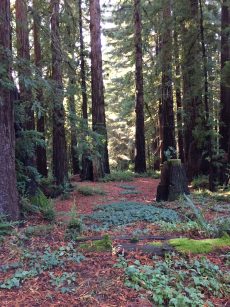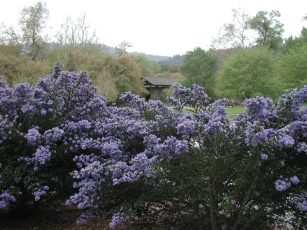You know when you walk out the door how hot or cold it is, how windy, shady, moist or dry. You know if your soil is pure sand or hard clay because you?ve dug a few holes in your time. You don?t need a book to tell you these things. So why are the gardening zones described in Sunset Western Gardening book important when you add a new plant to your garden ? And why are they so confusing in our area?

We all rely on Sunset’s Western Garden Book as the bible for gardeners. With each new edition I look to see if they’ve figured out that Felton is not in zone 7. Sure Felton gets pretty cold but even with climate change the San Lorenzo and Scotts Valleys are not as cold as a zone 7. Even considering microclimates we can grow a wide variety of plants that would not survive in the Sierra foothills, the Gabilan range, the Coast range or other zone 7 areas. Wish they would ask local nurseries and knowledgeable horticulturist what the weather and climate are really like here.
Knowing the climate in your area helps determine what you can grow in your garden. It’s confusing to both new and seasoned gardeners alike. Here are some tips to help you determine in which zone you garden.
We really only garden in two zones around here – zone 15 and 16. The Sunset map erroneously shows Felton as being in zone 7. Based on my experience even ridge tops like the highest portions of Bonny Doon and the Summit area which gets an occasional dusting of snow fall mostly in a colder zone 15.
Zone 15 – this zone encompasses most of our area. Winter lows average 20-30 degrees. The valley floor of both San Lorenzo and Scotts Valley lie in this zone and are what I call “a cold zone 15. Cold air sinks and is trapped in these areas. There are warmer parts of this zone, though. These areas rarely get a freeze after March 15th or before Thanksgiving.
Zone 16 – those who live up off the valley floor but below ridge tops live in this “banana belt”. Light frost can occur during the winter but mostly the winter lows in this zone stay near or above freezing. You might have cold pockets on your property however so plan accordingly.
Beside the zone you also need to note how much sun or shade you get during the growing season. There may also be microclimates on your property. Are you near the river in a canyon or gulch or up on a south facing slope? Some areas in your garden may be several degrees warmer than other spots such as up against a brick wall or at the top of a slope from where cold air drains. Planting a citrus at the top of a slope that drains away the cold will make your tree much happier than if planted in a low open area.
Soil quality is not taken into consideration in zone mapping. Since the soil houses the water and nutrient uptake system for most plants, it plays an important role. Most plant guides describe soil requirements in terms of well-drained, acid or alkaline, poorly drained or high organic matter.
If you have questions about which zone you are in, email me and I’d be happy to help. I hope this helps in choosing plants that will thrive in your garden.



